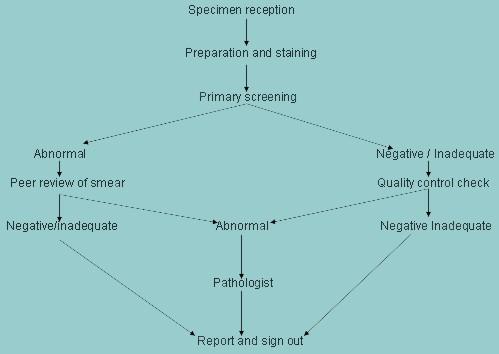This content is also available in:
English
Italiano
Español
Čeština
Polski
Minõségbiztosítás= rendszerszerüen kiépített minõség ellenõrzési eljárások folyamatos alkalmazása, ezek biztosítják az folyamatos magas szintü teljesitményt.
Minõségellenõrzés= Olyan eljárások alkalmazása, melyek biztosítják, hogy a kenetek értékelése és leletezése a lehetõ legpontosabb legyen.
Minõségi standardok= helyi, nemzeti és nemzetközi standardok, melyek mérésére és ellenõrzése a leghelyesebb laboratoriumi gyakorlato hivatott tükrözni
A minõségbiztosítás típusai
A minõségbiztosítási rendszerek lehetnek belsõk és külsõk
- Belsõ minõségbiztosítási rendszer (IQA) a laboratoriumon belü napi rendszerben müködik: ilyen pl. az adatbevitel vagy a mikroszkópos elõszürés menetének ellenõrzése
- Külsõ minõségbiztosítási rendszereket (EQA) egy külsõ szabályozó testület alkalmaz, pl. Szakmai színvonalat ellenõrzõ programok, akkreditáció útján

Internal quality assurance (IQA) measures to be taken on a daily basis
| Errors encountered | IQA measures |
|---|---|
| Specimen reception | |
| Errors at the point of reception are usually due to mismatching of smears and request forms. |
|
| Specimen processing | |
| Poor quality staining and fixation is the single most likely cause of errors of reporting cervical smears. |
|
| Specimen interpretation | |
| The commonest error is false negative reporting |
|
A cervix kenetek értékelése nagy gyakorlatot és koncentrációt igénylõ, állandóan ismétlõdõ monoton feladat. Elõszürõ végzi, aki ép hámsejtek ezrei között hivatott a relative ritkán elõforduló kóros sejteket elkülöniteni. Ezért magas az ál-negativ leletek keletkezésének kockázata. Minõségbizotsitási módszerek alkalmazása az ál- negativ leletek kockázatának csökkentésére minden citológiai laboratoriumban kötelezõ.

